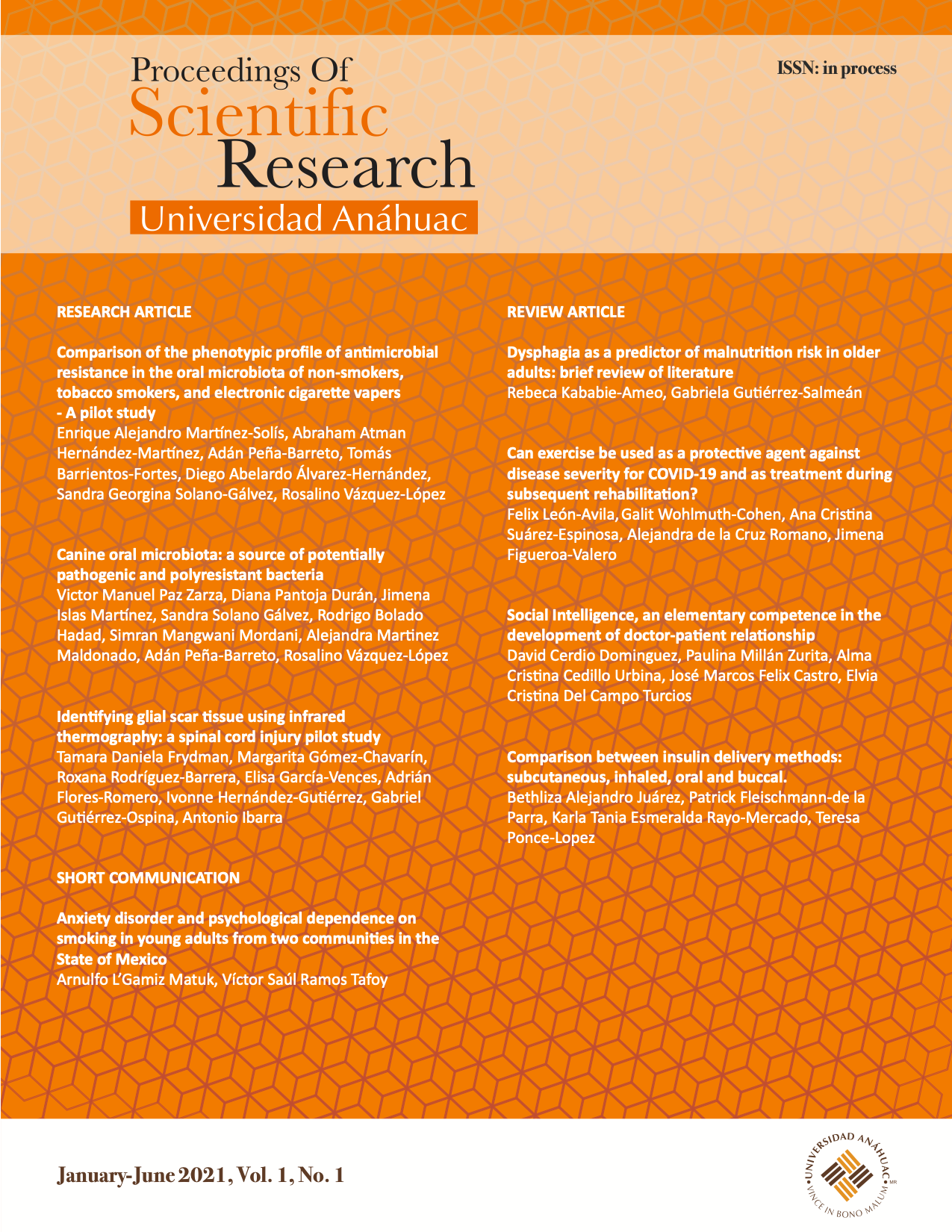Canine oral microbiota: A source of potentially pathogenic polyresistant bacteria
DOI:
https://doi.org/10.36105/psrua.2021v1n1.02Keywords:
resistencia, antibióticos, microbiota oral, caninosAbstract
Introduction: The current rise in polyresistant bacterial strains is due to self-medication, failure to comply the treatment, incorrect prescription of antibiotics by the physician, and even the abuse of these in agriculture industries. In this research, we suggest another possible source. Humans, being in coexistence with dogs and in contact with their saliva, could have been exposed to polyresistant microorganisms that are potential pathogens to. Identify, isolate and analyze these possible microorganisms were the main objectives of this study. Materials and methods: Oral samples (n=28) from domestic dogs were taken and cultured. Bacterial colonies (n = 160) were obtained and subjected to identification and antimicrobial sensitivity tests. Results: From 160 isolated colonies, the most prevalent species was Staphylococcus haemolyticus. Other bacteria such as Enterococcus faecium, Escherichia coli, Proteus mirabilis, and Pseudomonas aeruginosa were also found in a lesser proportion. There was an increased resistance of the bacteria against cell wall synthesis antibiotics. The resistance towards vancomycin was the highest, followed by cefalotin and cefixime. In contrast, all bacteria were sensible to imipenem. Conclusion: The resistance observed against protein synthesis inhibitors showed a high resistance towards erythromycin and clarithromycin but a high sensibility to amikacin and gentamicin. In this study several human pathogens that are the cause of infectious diseases were identified in the oral microbiota of dogs. Furthermore, another risk of polyresistant bacteria transmission is proposed with the determination of each bacterial resistance.
Downloads
PLUMX metrics
References
2. Mukerji S, O´Dea M, Barton M, Kirkwood R, Lee, T, Abraham S. Development and transmission of antimicrobial resistance among Gram-negative bacteria in animals and their public health impact. Essays Biochem. 2017; 61: 23-35. https://doi.org/10.1042/EBC20160055
3. Jobbins, S. Alexander, K. From whence they came antibiotic-resistant Escherichia coli in African wildlife. J Wildl Dis. 2015; 51: 811-820. https://doi.org/10.7589/2014-11-257
4. Song S, Lauber C, Costello E, Lozupone C, Humphrey G, Berg-Lyions D, Caporasso J, et al. Cohabiting family members share microbiota with one another and with their dogs. Elife. 2013;16: 2. https://doi.org/10.7554/eLife.00458.001
5. Booij-Vrieling HE, van der Reijden WA, Houwers DJ, de Wit WEAJ, Bosch-Tijhof CJ, Penning LC, et al. Comparison of periodontal pathogens between cats and their owners. Vet Microbiol. 2010;144: 147–152. https://doi.org/10.1016/j.vetmic.2009.12.046
6. Marsh P. Microbial ecology of dental plaque and its significance in health and disease. Adv Dent Res. 2014; 8: 263-271. https://doi.org/10.1177/08959374940080022001
7. The Human Microbiome Project Consortium. Structure, function and diversity of the healthy human microbiome. Nature. 2012; 486 :207-214. doi: 10.1038/nature11234. https://doi.org/10.1177/08959374940080022001
8. Ohler R, Velez A, Mizrachi M, Lamarche J, Gompf S. Bite-related and septic syndromes caused by cats and dogs. Lancet Infect Dis. 2019; 9: 439-447. https://doi.org/10.1016/S1473-3099(09)70110-0
9. Changin O, Kunkyu L, Yeotaek C, San-wong L, Seung-Yong P, Chang S, In-Soo C, et. al. Comparison of the oral microbiomes of canines and their owners using next-generation sequencing. PLoS One. 2015;10. https://doi.org/10.1371/journal.pone.0131468
10. Elliot D, Wilson M, Buckley C, Spratt D. Cultibable oral microbiota of domestic dogs. J Clin Microbiol. 2015;43: 5470-5476. https://doi.org/10.1128/JCM.43.11.5470-5476.2005
11. Constanza L, Antolinez D, Bohórquez J, Corredor Aura. Identification of bucal Microbiota in Canines in State of Abandonment. NOVA. 2019; 17 (32): 39-64. https://doi.org/10.22490/24629448.3632
12. Czekaj T, Ciszewski M, Szewczyk E. Staphylococcus Haemolyticus - An Emerging Threat in the Twilight of the Antibiotics Age. Microbiology. 2015;161(11): 2061-8. https://doi.org/10.1099/mic.0.000178
13. Yamasaki Y, Nomura R, Nakano K, Naka, S, Matsumoto-Nakano M, Asai F, Ooshima T. Distribution of periodontopathic bacterial species in dogs and their owners. Arch Oral Biol. 2012; 57:1183-1188. https://doi.org/10.1016/j.archoralbio.2012.02.015
14. Van Tyne D, Martin M, Gilmore M. Structure, Function, and Biology of the Enterococcus faecalis Cytolysin. Toxins (Basel). 2013 May; 5(5): 895–911. https://doi.org/10.1002/ncp.10085
15. Drzewiecka D. Significance and Roles of Proteus spp. Bacteria in Natural Environments. Microb Ecol. 2016; 72: 741–758. https://doi.org/10.1007/s00248-015-0720-6
16. Vijayakrishnan R, Alwyn R. Fatal Enterococcus durans aortic valve endocarditis: a case report and review of the literature. BMJ Case Rep. 2012; https://doi.org/10.1136/bcr-02-2012-5855
17. Michael A Washington, Jason Barnhill, Jaclyn M Griffin. A Case of Wound Infection with Providencia rettgeri and Coincident Gout in a Patient from Guam. Hawaii J Med Public Health. 2015; 74: 375–377.
18.Bridget E. Shields, Amanda J. Tschetter, Karolyn A. Wanat. Staphylococcus simulans: An emerging cutaneous pathogen. JAAD Case Rep. 2016; 2: 428–429. https://doi.org/10.1016/j.jdcr.2016.08.015
19. Fata M, Gohds S, Bernd H. A. (2017). Rehm. Pseudomonas aeruginosa Lifestyle: A Paradigm for Adaptation, Survival, and Persistence. Front Cell Infect Microbiol. 7, 39. Published online 2017 Feb 15. https://doi.org/10.3389/fcimb.2017.00039
20. Dan Li, Zhicheng Zhu, Xiaomei Zheng, Weitie Wang, Rihao Xu, Kexian Liu. Gemella morbillorum endocarditis of pulmonary valve: a case report. J Cardiothora Surg. 2016; 12: 16. https://doi.org/10.1186/s13019-017-0579-3
21. Stogios P, Savchenko A. Molecular Mechanisms of Vancomycin Resistance. Protein Sci. 2020; 29(3): 654-669. https://doi.org/10.1002/pro.3819
22. Gashe F, Mulisa E, MekonnenM, Zeleke G. Antimicrobial Resistance Profile of Different Clinical Isolates against Third-Generation Cephalosporins. J Pharm. 2018: 5070742. https://doi.org/10.1155/2018/5070742
Downloads
Additional Files
Published
How to Cite
Issue
Section
License
Copyright (c) 2021 Victor Manuel Paz Zarza, Diana Pantoja Durán, Jimena Islas Martínez, Sandra Solano Gálvez, Rodrigo Bolado Hadad, Simran Mangwani Mordani, Alejandra Martinez Maldonado, Adán Peña Barreto, Rosalino Vázquez-López

This work is licensed under a Creative Commons Attribution-NonCommercial-NoDerivatives 4.0 International License.
All the intellectual content found in this publication is licensed to the consumer public under the figure of Creative Commons©, unless the author of said content has agreed otherwise or limited said faculty to "Proceedings of Scientific Research Universidad Anáhuac. Multidisciplinary Journal of Healthcare©" or "Universidad Anáhuac Mexico©" in writing and expressly.
Proceedings of Scientific Research Universidad Anáhuac. Multidisciplinary Journal of Healthcare is distributed under a Creative Commons Attribution-NonCommercial-NoDerivatives 4.0 International License.
The author retains the economic rights without restrictions and guarantees the journal the right to be the first publication of the work. The author is free to publish his article in any other medium, such as an institutional repository.










